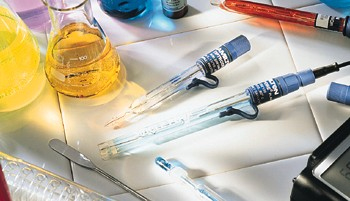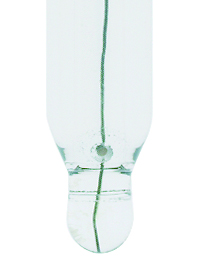
Cleaning & reconditioning pH electrodes
 Often the pH meters are used in applications, which require regular cleaning of the electrode. These applications involve very hard waters, dirty samples like soil slurries, viscous materials or samples with high oil and protein content. We do not recommend these procedures for persons unfamiliar with or unable to use safe techniques involving these chemicals: Detergents, HCl (Hydrochloric Acid), and NaOH (Sodium Hydroxide).
Often the pH meters are used in applications, which require regular cleaning of the electrode. These applications involve very hard waters, dirty samples like soil slurries, viscous materials or samples with high oil and protein content. We do not recommend these procedures for persons unfamiliar with or unable to use safe techniques involving these chemicals: Detergents, HCl (Hydrochloric Acid), and NaOH (Sodium Hydroxide).
 Method 1
Method 1
Soak the electrode in a 0.4 molar concentration of HCl (hydrochloric acid) for 10 minutes, then rinse the electrode with deionized or distilled water. This should remove any organic protein from the glass electrode and the surface of the reference electrode.
Method 2
Soak the electrode in a 3.8 or 4.0 molar KCl (potassium chloride) solution heated to 50°C for 1 hour. Allow the KCl solution to cool down to room temperature, then rinse the electrode with deionized or distilled water. This will open and clean the reference electrode of all contaminants.
Method 3
Soak the electrode in a 4.01 pH buffer solution (EC-BU-4BT), heated to 50°C for 1 hour. Allow the buffer to cool down to room temperature, then rinse the electrode with deionized or distilled water. This will open and clean the reference electrode.
Method 4
After each use, rinse the electrode in 0.5 N or 1% HCl. If you have a build-up of oil or protein contaminants, try soaking the electrode in warm detergent and water solution. Degreasing dishwashing detergents or stain removing pre wash pretreatment are ideal for this: any brand will do. An overnight soak may be needed if build-up is heavy. Then rinse the pH sensor in deionized or distilled water and soak for 10 minutes in 1% HCl. Rinse the pH sensor in deionized or distilled water and check in buffers. If the pH sensor calibrates to buffers it can be used in tests. When the pH electrode cannot be calibrated even after attempts to clean it, it must be replaced.
Method 5
For protein removal, soak the pH electrode in contact lens enzymatic cleaner solution overnight. The enzymes will remove proteins from glass and plastic.





 0
0
 0
0